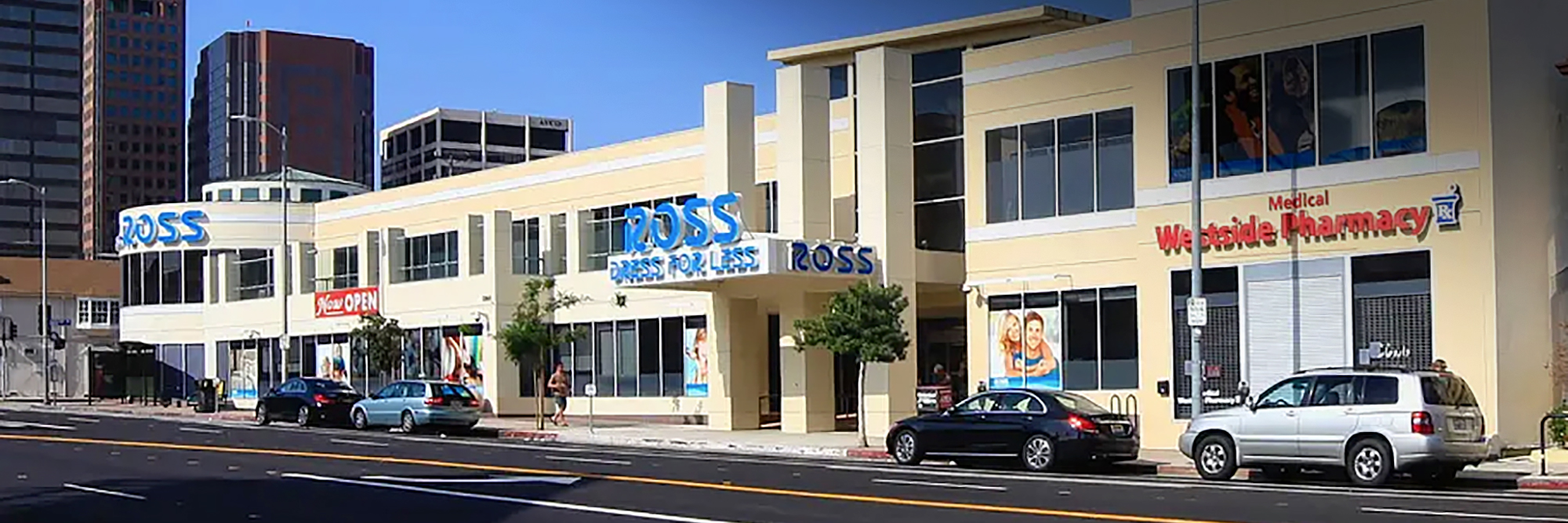
Westwood Waterproofing:
Protecting a Prime Retail Location
Few Westwood properties boast a better location than 1380 Westwood Boulevard. Situated near the intersection of Westwood Boulevard and Wilshire Boulevard, close to UCLA and I-405, this two-floor, 45,000-square foot retail/office center with above- and below-ground parking has never wanted for tenants. Yet even premiere properties are vulnerable to the elements, particularly water damage, which had attacked the property in several locations.
CHALLENGE
After a thorough inspection, HSG identified three principal areas in need of immediate remediation:
- PARKING RAMP, NORTHEAST ENTRY: A multitude of cracks above ground allowed water to seep into the structure and drip onto parked vehicles, corroding their finishes and subjecting building ownership to costly repairs. Approximate square footage: 1,820 square feet
- LOADING DOCK AREA. Here, too, water damage had led to extensive cracking in the concrete, weakening the structure and creating safety issues that had to be addressed. Approximate square footage: 450 square feet
- METAL-TO-CONCRETE CAULKING AT THE BASE OF THE BUILDING. Years had passed without significant upkeep, leading to large gaps through which water was able to enter the building, leaving walls, ceilings, office furniture and equipment vulnerable to damage. Approximate work area: 620 linear feet

When we arrived, we could see clear evidence of degradation indicating that the structure was no longer waterproof.

Extensive cracking at the entrance to the underground garage allowed water to seep through the concrete and damage vehicles parked there.
SOLUTION
HSG addressed the parking garage and loading dock simultaneously. The first step was to remove old materials where sealant had been applied in the past. In order to identify all the cracks, however, it was essential to grind the concrete surface, a process that clears away any sediment and debris that may be obscuring the areas we need to address.
Once the cracks were fully visible, we sealed them with urethane caulking and allowed them to cure for 24 hours. Next, we pressure washed the surface and allowed it to dry thoroughly overnight. Upon our return, our team applied an epoxy primer, followed by a base coat of urethane (minimum thickness: 11mm).
Next we applied an intermediate coat of elastomeric, which is thick, spreadable and flexible like a rubber. Unfortunately, it’s also quite slippery, so we then applied aggregate to give people and vehicles the traction they need. The next day we returned to apply another coat of elastomeric to cover and seal the aggregate. Where there were concrete joints, those were treated as well.
The process for addressing cracks in the metal-to-concrete caulking around the base of building is similar in nature to our method of waterproofing the ramp and loading dock, but it required different materials. After removing old sealant and grinding the surfaces, we cleaned the joints with alcohol, applied masking tape along the edges, and then applied a Sika primer 29. This cured for 20 minutes, after which we applied the Sika urethane caulking on the joints, using specialized tools to smooth them. A chief benefit of the Sika urethane is its compatibility with paint and elastomeric.

Before applying the new sealant, it’s essential to remove the existing coating, wash the surface thoroughly, and caulk the joints.

There’s an art to removing the existing coating from ramp – but also brutal craft. The end result is a surface that’s perfectly primed for waterproofing.

The old coating comes off in rubbery strips.


Sealant must be thoroughly and carefully applied to deny water any opportunity to seep through the protective barrier.

Waterproofing is a meticulous process that involves a perfectly timed sequence of cleaning, application, setting/drying, and reapplication.
RESULT
HSG’s no-shortcuts approach to waterproofing addressed 1380 Westwood Boulevard’s vulnerabilities to water damage. Moreover, with regular upkeep it will defend the building against the elements for years to come.


Upon completion, the parking entrance – now coated, sealed and striped – is completely transformed and ready to withstand at least a decade of exposure to the elements.



